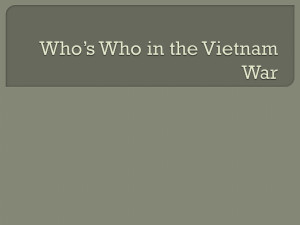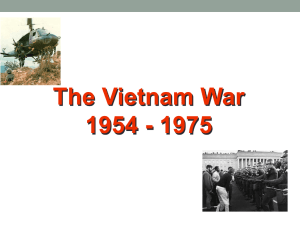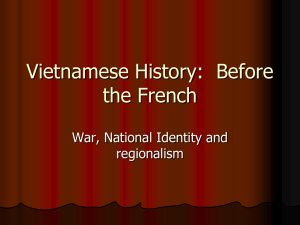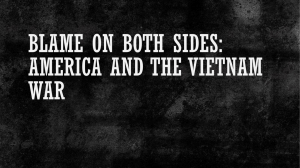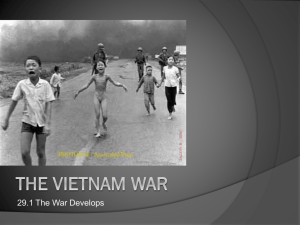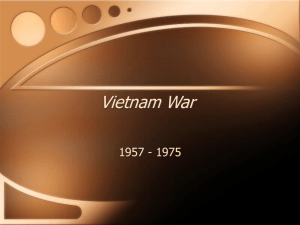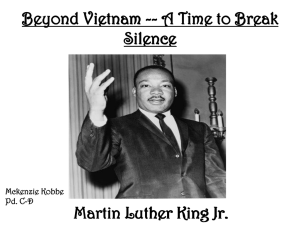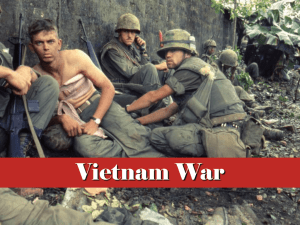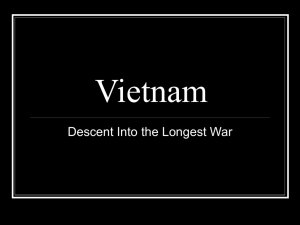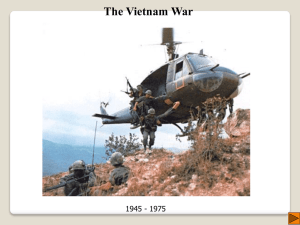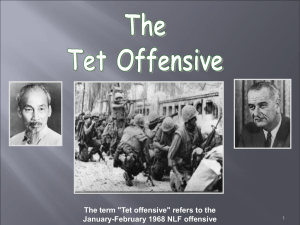Vietnam2
advertisement
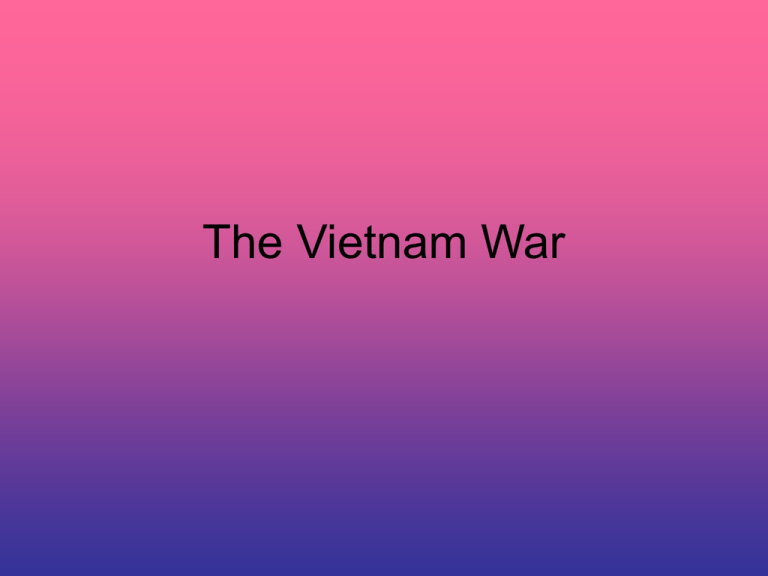
The Vietnam War 1941-1954 (First Indochina War) • 1941 – League for the Independence of Vietnam (Viet Minh) created (dominated by Communists / led by Ho Chi Minh) • 1945 – Ho Chi Minh, thinking he has US support, declares Vietnam independent. • Post WWII – Vietnam placed under the control of China and Britain / eventually the French convince the US to give Vietnam back to them. • War breaks out btw. the Viet Minh and the French. • Why did this happen? 1941-1954 (cont.) • US provides aid ($ and weapons) to France. • 1950 – Communist China and the USSR recognize Vietnamese independence. • 1954 – French crushed at Dien Bien Phu leading to and end to the war. • Geneva Conference – Vietnam partitioned into North and South (North – communist under Ho Chin Minh / South – Ngo Dinh Diem prime minister). French troops captured at Dien Bien Phu (almost 12,000 French soldiers were captured). President Dwight Eisenhower meets with Prime Minister Diem. 1955-1963 (Things Fall Apart) • Partition was supposed to be temporary (elections were supposed to happen). • Why don’t they happen? • 1955 – rigged elections in the South result in 98% of the people voting for Diem to be President. • Diem’s Rule characterized by corruption and human rights violations: • Those suspected of being communist were rounded up and killed. • Buddhist organizations were targeted (Diem was a devout Catholic). • Diem and his brother Ngo Dinh Nhu used their positions of power to gain for themselves. Buddhist monk sets himself on fire to protest Diem’s government. 1955-1963 (cont) • 1957 – insurgency develops in the South in response to Diem’s govt. (Viet Cong) • 1960 – Ho Chi Minh agrees to begin a military operation to liberate the South. • Pres. Kennedy increases the amount of US forces in Vietnam from 700 to 12,000. • CIA lets it be known that the US would not attempt to stop an overthrow of Diem. 1955-1963 (cont.) • Nov. 1963 – Diem and his brother are removed from power and executed. • South Vietnam is ruled by chaos / US forces in Vietnam – over 16,000 1964-1968 (Second Indochina War begins) • Aug. 1964 – Gulf of Tonkin incident leads to Congress granting LBJ military powers. – Empowered President Johnson to: • “To take all necessary steps to repel armed attack against US forces” • “To take all necessary steps, including force, to assist S Vietnam and any member of SEATO” • March 1965 – Operation Rolling Thunder begins (US bombs North Vietnam to eliminate their support of the insurgency). • Dec. 1965 – 200,000 US marines in Vietnam to protect US air bases. • South Vietnamese army continues to be crushed by the insurgency. Operation Rolling Thunder in action. 1964-1968 cont. • Gen. William Westmoreland begins to push for a more offensive role for US ground forces. (predicts victory by 1967) – By 1969, U.S. troop strength reached 543,000 (500,000 supported the war from other Asian countries and Pacific bases) • U.S. became heavily involved in fighting a guerrilla war-- they were not prepared • 1968 – Tet Offensive begins (military failure for the insurgency) • Why could the Tet Offensive be considered a political success? Vietcong Underground Tunnels Gen. Westmoreland on two of his three Time magazine covers in 1965 & 1967. 1968: Tet Offensive • North attacked 12 U.S. bases & Embassy • Objective: – Shatter South’s army & cause a civilian revolt – Tactical failure, huge strategic success – American confidence in war effort plummeted – Opposition to war increased significantly • After Tet, U.S. objective was to get out, quickly and gracefully Insurgent executed by the National Chief of Police. •Paris Peace Talks begin in 1968 but achieved nothing –North Vietnam knew time was on their side With Americans under fire in Vietnam, senior politicians turn on the President. Robert McNamara, who had been the chief architect of the war and had repeatedly assured the President and the U.S. public that victory would soon be at hand, suddenly decides to leave office. McNamara is replaced by Clark Clifford. Clifford convinces Johnson that the war cannot be won on the battlefield. Peace talks begin in Paris. 1969-1975 (American withdrawal and defeat) • 1969 – Pres. Nixon proposes “peace with honor” plan (vietnamization) • U.S. forces begin withdrawing June 1969 – By 1972, 200,000 U.S. troops had left Vietnam • Sept. 1969 – Ho Chi Minh dies • 1969 – US begins bombing insurgent supply lines and bases in Cambodia. • 1970 – US & SV forces attack supply lines in Cambodia • 1971— US fighter-bombers launch strikes against supply lines in Laos and Cambodia Battle of Hamburger Hill, May 1969 -Forty-six men of the 101st Airborne die during a fierce ten-day battle at 'Hamburger Hill' in the A Shau Valley near Hue. 400 others are wounded. After the hill is taken, the troops are then ordered to abandon it by their commander. NVA then move in and take back the hill unopposed. -The costly assault and its confused aftermath provokes a political outcry back in the U.S. that American lives are being wasted in Vietnam. One Senator labels the assault "senseless and irresponsible.“ -It is the beginning of the end for America in Vietnam as Washington now orders MACV Commander Gen. Creighton Abrams to avoid such encounters in the future. 'Hamburger Hill' is the last major search and destroy mission by U.S. troops during the war. Small unit actions will now be used instead. -A long period of decline in morale and discipline begins among American draftees serving in Vietnam involuntarily. Drug usage becomes rampant as nearly 50 percent experiment with marijuana, opium, or heroin which are easy to obtain on the streets of Saigon. U.S. military hospitals later become deluged with drug related cases as drug abuse causalities far outnumber causalities of war. 1969-1975 cont. • 1972 – Easter Offensive – insurgents & NVA capture the northern section of SV • 1972 – US begins secretly negotiating with the North Vietnamese govt. • 1973 – Paris Peace Accords – US officially pulls out of Vietnam / elections to be held • 1975 – North Vietnamese begin offensive after elections are not happening. • April 1975 – Saigon (capital of the South) falls. Final Toll • • • • • America’s most unpopular war America’s longest and most expensive war Best technical war money could buy Overwhelmingly won tactical battles Could not win the war Final Toll—Costs • Human Toll: – 58,135 Americans killed, 153,000 wounded, 2500 missing in action – South Vietnam – 243,000 military / 300,000 civilian – North Vietnam/insurgency – 666,000 military / 65,000 civilian • $141 Billion spent – Inflation tripled by the end of 1960s – In exchange for a tax increase in ‘67, Republicans demanded that there be a $6 billion reduction in Great Society funding – “That war…,” Johnson later admitted, “killed the lady I really loved—the Great Society.” • 6.3 Million tons of bombs dropped – 12x more than Korea, 2x more than WW II • 2,257 aircraft lost ($3.1 Billion value) • 5.2 Million combat sorties flown Final Toll—Political • U.S. reluctance to enter military conflicts that don’t directly threaten national interests • Congressional restriction on President’s ability to commit U.S. military forces – War Powers Act of 1973 • President must inform Congress w/in 48 hrs if troops sent • Troops may remain up to 90 days w/out Congressional declaration of war • Lessened public opinion of government and military – “Credibility Gap”—TV footage of American in body bags contradicted the gov’t & military optimistic account of progress and imminent Vietcong surrender • Public divided over the war – Doves-those opposed to the war – Hawks-those in support of more military force to win the war Final Toll—Political Pentagon Papers, 1971 -7,000 page Defense Department report written for Defense Secretary Robert McNamara in 1967-1968 -Revealed gov’t involvement in Vietnam dating back to 1940s Truman: military aid to France in war against Vietminh Eisenhower: direct involvement in preventing 1956 elections Johnson: Gov’t had plans drawn for entering the war prior to Gulf of Tonkin Resolution There was never any plan to end the war as long as North Vietnam continued to fight THE COSTS OF WAR

